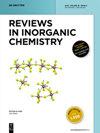Review elucidating graphene derivatives (GO/rGO) supported metal sulfides based hybrid nanocomposites for efficient photocatalytic dye degradation
IF 3.1
3区 化学
Q1 CHEMISTRY, INORGANIC & NUCLEAR
引用次数: 7
Abstract
Abstract Photocatalysis by utilizing semiconductors for the removal of toxic pollutants has gained tremendous interest for remediation purposes. The organic pollutants usually include; pesticides, dyes and other phenolic compounds. An imperative restraint associated with the photocatalytic effectiveness of the catalyst is the rapid recombination of the light generated electrons and holes. The particle agglomeration and electron-hole recombination hinders the rate of pollutant removal. For decades, researchers have used metal-sulfides efficiently for photocatalytic dye degradation. The recent use of hybrid nanomaterials with the combination of graphene derivatives such as graphene oxide and reduced graphene oxide (GO/rGO)-metal sulfide has gained interest. These composites have displayed an impressive upsurge in the photocatalytic activity of materials. The current review describes the various researches on dye photodegradation by employing (GO/rGO)-metal sulfide, exhibiting a boosted potential for photocatalytic dye degradation. A comprehensive study on (CuS, ZnS and CdS)–GO/rGO hybrid composites have been discussed in detail for effective photocatalytic dye degradation in this review. Astonishingly improved dye degradation rates were observed in all these studies employing such hybrid composites. The several studies described in the review highlighted the varying degradation rates based on diverse research parameters and efficacy of graphene derivatives for enhancement of photocatalytic activity.石墨烯衍生物(氧化石墨烯/还原氧化石墨烯)负载的金属硫化物基杂化纳米复合材料用于高效光催化降解染料的研究进展
摘要利用半导体进行光催化去除有毒污染物已引起人们对修复目的的极大兴趣。有机污染物通常包括:;杀虫剂、染料和其他酚类化合物。与催化剂的光催化效率相关的一个必要限制是光产生的电子和空穴的快速复合。颗粒团聚和电子空穴复合阻碍了污染物的去除率。几十年来,研究人员一直有效地使用金属硫化物进行光催化降解染料。最近,将混合纳米材料与石墨烯衍生物(如氧化石墨烯和还原氧化石墨烯(GO/rGO)-金属硫化物)结合使用引起了人们的兴趣。这些复合材料在材料的光催化活性方面显示出令人印象深刻的热潮。综述了利用(GO/rGO)-金属硫化物对染料进行光降解的各种研究,显示出光催化降解染料的潜力。本文详细讨论了(CuS、ZnS和CdS)-GO/rGO杂化复合材料在有效光催化降解染料方面的综合研究。在使用这种杂化复合材料的所有这些研究中都观察到染料降解率的惊人提高。综述中描述的几项研究强调了基于不同研究参数的不同降解率以及石墨烯衍生物增强光催化活性的功效。
本文章由计算机程序翻译,如有差异,请以英文原文为准。
求助全文
约1分钟内获得全文
求助全文
来源期刊

Reviews in Inorganic Chemistry
化学-分析化学
CiteScore
7.30
自引率
4.90%
发文量
20
审稿时长
1 months
期刊介绍:
Reviews in Inorganic Chemistry (REVIC) is a quarterly, peer-reviewed journal that focuses on developments in inorganic chemistry. Technical reviews offer detailed synthesis protocols, reviews of methodology and descriptions of apparatus. Topics are treated from a synthetic, theoretical, or analytical perspective. The editors and the publisher are committed to high quality standards and rapid handling of the review and publication process. The journal publishes all aspects of solid-state, molecular and surface chemistry. Topics may be treated from a synthetic, theoretical, or analytical perspective. The editors and the publisher are commited to high quality standards and rapid handling of the review and publication process.
Topics:
-Main group chemistry-
Transition metal chemistry-
Coordination chemistry-
Organometallic chemistry-
Catalysis-
Bioinorganic chemistry-
Supramolecular chemistry-
Ionic liquids
 求助内容:
求助内容: 应助结果提醒方式:
应助结果提醒方式:


